Entomology, Ornithology & Herpetology: Current Research
Open Access
ISSN: 2161-0983
ISSN: 2161-0983
Short Communication - (2023)Volume 12, Issue 1
Net entanglement in derelict fishing nets is a major threat to the conservation of endangered species of cetaceans, birds and reptiles. Nets made of nylon and plastics are non degradable and are a major source of risk to many species whether aquatic or terrestrial which often get trapped and killed which continue to be present in the environment even when not in use. Lack of awareness and careless handling of these fishing gears by fishermen poses serious damaging impact on the biodiversity and ecological health of the habitat.
Net entanglement; Potential hazard; Monofilament netting; Biodiversity loss
One of the most urgent threats to the world's remaining marine stocks is commercial fishing, especially the indiscriminate capture of non target organisms, typically referred to as ‘bycatch’ [1,2]. Whilst bycatch may be sold, it may also be unusable or unwanted for a variety of regulatory and economic reasons and subsequently thrown back to sea, often dead or dying [3]. The role of bycatch in degrading marine ecosystems has made this one of the most significant nature conservation issues in the world today [4].
A variety of light weight, inexpensive monofilament netting made of polypropylene or polyethylene plastic has been widely available in recent decades in which many of these have proven to be harmful to animal when used in wildlife habitat [5]. In the past there have been isolated reports of terrestrial and semi aquatic snakes being entangled or entrapped in mesh netting and other plastic debris.
Consequently, the first author “AP” runs an animal rescue organization that deals with large numbers of rescue requests for snakes. After rescuing animals, they are released into relatively safer and remote forest habitats under the guidance and direction of the local forest department.
During a span of over two months, from March 2022 through the end of May 2022, this organization rescued a total number of 23 individuals of snakes of six different species in Gujarat, India (22.2587°N, 71.1924°E) (Table 1).
| Species name | Number of net trapped individuals found | IUCN status |
|---|---|---|
| Fowlea piscator | 5 | Least concern |
| Eryx conicus | 1 | Near threatened |
| Ptyas mucosa | 4 | Least concerned |
| Daboia russelii | 5 | Least concern |
| Python molurus | 8 | Near threatened |
| Naja naja | 6 | Least concern |
Table 1: Record of net trapped cases of different species found from Gujarat, India.
The Checkered keelback, Fowlea piscator, is widely dispersed throughout Southern Asia, where it occurs along rivers, ponds and paddy fields. It is one of the most frequently encountered aquatic snakes and possibly the most abundant snake in India. These snakes are extremely active, capable of jumping off the ground and swimming nimbly in water. They eat frog eggs, tadpoles, frogs, fish, rodents and occasionally birds.
Common Sand boa Eryx conicus is distributed across Pakistan, Nepal, India and Sri Lanka [6]. This burrowing, semi fossorial, nocturnal (sometimes seen as diurnal) snake inhabits arid and semi-arid regions. It feeds mainly on lizards, rodents, frogs, small mammals and birds. Eryx conicus is placed under the near threatened category in the IUCN red list as shown in Figures 1 to 3.
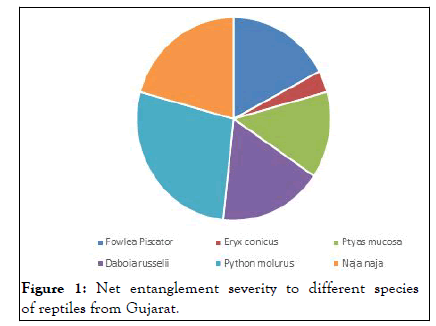
Figure 1: Net entanglement severity to different species
of reptiles from Gujarat.
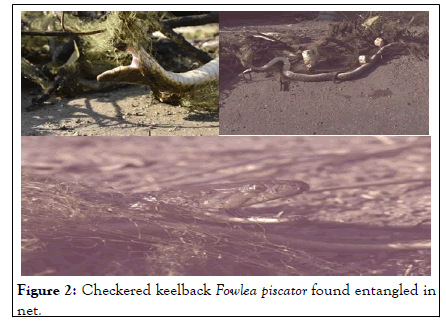
Figure 2: Checkered keelback Fowlea piscator found entangled in
net.
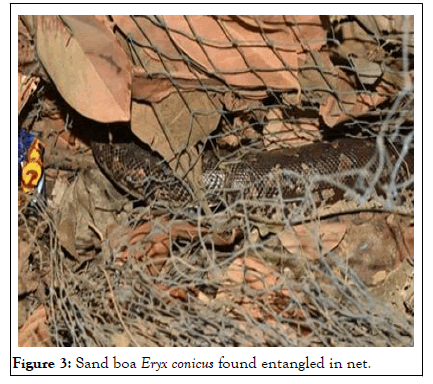
Figure 3: Sand boa Eryx conicus found entangled in net.
The Indian ratsnake, Ptyas mucosa, is a large, non-venomous, predominantly diurnal colubrid snake widely distributed throughout the Indian subcontinent (including the Andaman Archipelago), Bangladesh, Eastern Iran, Turkmenistan, Afghanistan, and Southeastern Asia. These snakes inhabit a wide variety of habitat types including forests and urban areas from sea level to 4,000 m.a.s.l.
Russell's viper Daboia russelii is a venomous snake in the family viverridae native to the Indian subcontinent and one of the big four snakes in India as shown in Figures 4 and 5.
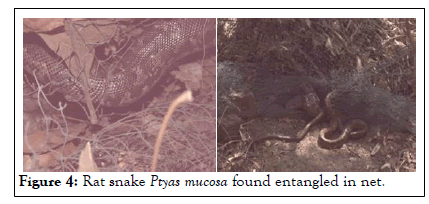
Figure 4: Rat snake Ptyas mucosa found entangled in net.
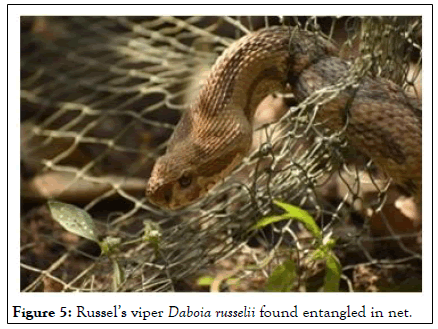
Figure 5: Russel’s viper Daboia russelii found entangled in net.
The Indian rock python, Python molurus, is a large non venomous snake found throughout most of tropical and subtropical Southern and Southeastern Asia. The species is widely distributed on the Indian subcontinent and is frequently encountered in Gujarat State. This species has been categorized as schedule-I in the Indian Wildlife Protection Act (IWPA) of 1972, is listed in Convention on International Trade in Endangered Species (CITES), but has not been assessed for the IUCN red List since the elevation of P. bivittatus, which until recently was considered a subspecies of P. molurus.
The Indian spectacled cobra Naja naja is sympatric with two other cobra species. This is one of the four common venomous snakes found in India with medical importance. The spectacled cobra (Naja naja) is a large (maximum total length>2 m), venomous, primarily diurnal elapid found throughout the Indian Subcontinent, where it lives in a variety of habitats including forests and urban areas from sea level to 2,000 m asl [7,8]. The spectacled cobra has a double eye shaped mark on its hood, while the Monocled and Andaman Cobras have a single eye shaped mark. The spectacled cobra (Naja naja) is another name for the Indian cobra (Naja naja) as shown in Figures 6 and 7.
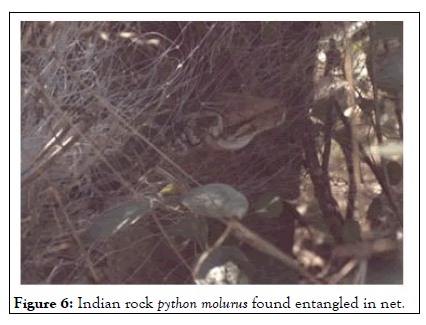
Figure 6: Indian rock python molurus found entangled in net.
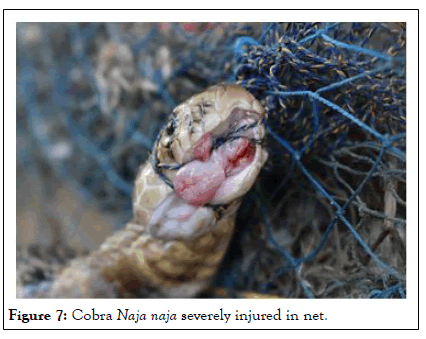
Figure 7: Cobra Naja naja severely injured in net.
Deleterious effects of fishing depend on gear loss rates and their catching efficiency, species composition and abundance and species vulnerability. Since majority of the gear is nowadays made of non-biodegradable synthetic materials, such as nylon, polyethylene, or polypropylene, they can persist and continue fishing for long periods in the environment and pose a serious potential danger to several terrestrial and aquatic species which get entrapped and often get injured to death.
We are thankful to VSPCA, Gujarat for their efforts for coastal ecosystem. We thank earth crusaders organization for literature citation.
The authors declare no conflict of interest during the preparation of this article.
[Crossref] [Google Scholar] [PubMed]
[Crossref] [Google Scholar] [PubMed]
Citation: Patel A, Samal A, Pandey S (2023) Net Entanglement in Indian Rock Python Python molurus (Linnaeus 1758), Checkered Keelback Fowlea piscator (Schneider 1799), Common Sandboa Eryx conicus (Schneider 1801), Ratsnake Ptyas mucosa (Linnaeus 1758), Russel’s Viper Daboia russelii (Shaw 1797) and Spectacled Cobra Naja naja from Gujarat, India. Entomol, Ornithol and Herpetol. 12:296.
Received: 10-May-2022, Manuscript No. EOHCR-22-19074; Editor assigned: 13-May-2022, Pre QC No. EOHCR-22-19074 (PQ); Reviewed: 27-May-2022, QC No. EOHCR-22-19074; Revised: 04-Jan-2023, Manuscript No. EOHCR-22-19074 (R); Published: 18-Jan-2023 , DOI: 10.35248/2329-8731.23.12.296
Copyright: © 2023 Patel A, et al. This is an open-access article distributed under the terms of the Creative Commons Attribution License, which permits unrestricted use, distribution, and reproduction in any medium, provided the original author and source are credited